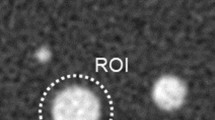Abstract
Purpose
The efficient use of computed tomography (CT) and magnetic resonance imaging (MRI) equipment necessitates establishing adequate quality-control (QC) procedures. In particular, the accuracy of slice thickness (ST) requires scan exploration of phantoms containing test objects (plane, cone or spiral). To simplify such procedures, a novel phantom and a computerised LabView-based procedure have been devised, enabling determination of full width at half maximum (FWHM) in real time.
Materials and methods
The phantom consists of a polymethyl methacrylate (PMMA) box, diagonally crossed by a PMMA septum dividing the box into two sections. The phantom images were acquired and processed using the LabView-based procedure.
Results
The LabView (LV) results were compared with those obtained by processing the same phantom images with commercial software, and the Fisher exact test (F test) was conducted on the resulting data sets to validate the proposed methodology.
Conclusions
In all cases, there was no statistically significant variation between the two different procedures and the LV procedure, which can therefore be proposed as a valuable alternative to other commonly used procedures and be reliably used on any CT and MRI scanner.
Riassunto
Obiettivo
Un parametro di fondamentale importanza da monitorare durante i controlli di qualità sulle apparecchiature di tomografia computerizzata (TC) e di risonanza magnetica (RM) è rappresentato dall’accuratezza dello slice thickness (ST), per la cui verifica i protocolli standard richiedono procedure complesse e fantocci dedicati. Al fine di semplificare tali procedure è stato realizzato un nuovo fantoccio e sviluppato un software in ambiente LabView per la determinazione della larghezza a metà del massimo (FWHM) del line profile in tempo reale.
Materiali e metodi
Il fantoccio consiste in una scatola con inserito diagonalmente un setto che divide il box in due sezioni, entrambi in polimetilmetacrilato (PMMA). Le immagini acquisite vengono processate mediante il software sviluppato.
Risultati
I risultati ottenuti con la metodologia LabView sono stati confrontati con quelli conseguiti elaborando le stesse immagini mediante un software commerciale. è stato inoltre condotto il test statistico di Fisher (F-test) al fine di validare ulteriormente la metodologia proposta.
Conclusioni
In tutti i casi analizzati non è emersa alcuna variazione statisticamente significativa tra le due diverse procedure, validando cosÌ la procedura messa a punto con il LabView. Pertanto, può essere proposta come una valida alternativa alle procedure comunemente adottate ed utilizzata indifferentemente in TC ed RM.
Similar content being viewed by others
References/Bibliografia
Torfeh T, Beaumont S, Guédon JP, Denis E (2007) Software tools dedicated for an automatic analysis of the CT scanner Quality Control’s Images. Conf Proc IEEE Eng Med Biol Soc 2007:3910–3913
Rehani MM, Bongartz G, Golding SJ et al (2000) Managing patient dose in computed tomography. Ann ICRP 30:7–45
Mutic S, Palta JR, Butker EK et al (2003) Quality assurance for computed-tomography simulators and the computed tomography-simulation process: Report of the AAPM radiation therapy committee task group no. 66. Med Phys 30:2762–2792
Vermiglio G, Testagrossa B, Sansotta C, Tripepi MG (2006) Radiation protection of patients and quality controls in teleradiology. Proceedings of the 2nd European Congress on Radiation Protection “Radiation protection: from knowledge to action”, Paris
Chen CC, Wan YL, Wai YY, Liu HL (2004) Quality assurance of clinical MRI scanners using ACR MRI phantom: Preliminary results. J Digit Imaging 17:279–284
Rampado O, Isoardi P, Ropolo R (2006) Quantitative assessment of computed radiography quality control parameters. Phys Med Biol 51:1577–1593
Goodsitt MM, Carson PL, Witt S et al (1998) Real-time B-mode ultrasound quality control test procedures — Report of AAPM ultrasound task group no.1. Med Phys 25:1385–1406
Narayan P, Suri S, Choudhary SR, Kalra N (2005) Evaluation of slice thickness and inter slice distance in MR scanning using designed test tool. IJRI 15:103–106
Judy PF, Balter S, Bassano D et al (1977) Phantoms for performance evaluation and quality assurance of CT scanners. AAPM Report No. 1.
Price RR, Axel L, Morgan T et al (1990) Quality assurance methods and phantoms for magnetic-resonance-imaging — Report of AAPM Nuclear-Magnetic-Resonance Task Group No-1. Med Phys 17:287–295
Testagrossa B, Novario R, Sansotta C et al (2006) Fantocci multiuso per i controlli di qualità in diagnostica per immagini. Proceedings of the XXXIII AIRP, Torino
Vermiglio G, Tripepi MG, Testagrossa B et al (2008) LabVIEW employment to determine dB/dt in Magnetic Resonance quality controls. Proceedings of the 2nd NIDays, Roma
Sansotta C, Testagrossa B, de Leonardis R et al (2002) Remote image quality and validation on radiographic films. Proceedings of the 7th Internet World Congress for Biomedical Sciences, INABIS 2002
Markowski CA, Markowski EP (1990) Conditions for the effectiveness of a preliminary test of variance. The American Statistician 44:322–326
Author information
Authors and Affiliations
Corresponding author
Rights and permissions
About this article
Cite this article
Acri, G., Tripepi, M.G., Causa, F. et al. Slice-thickness evaluation in CT and MRI: an alternative computerised procedure. Radiol med 117, 507–518 (2012). https://doi.org/10.1007/s11547-011-0775-5
Received:
Accepted:
Published:
Issue Date:
DOI: https://doi.org/10.1007/s11547-011-0775-5




